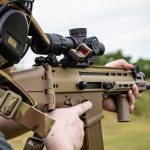With an uncertain world, one insurance policy to keep you ahead of the pack that is easy to maintain is a good combat handgun and the items needed to keep it working indefinitely.
Being a “prepper” does not mean one is a whack job or “survivalist” these individuals simply spend their spare time, sweat, and coin to better make themselves ready for, well, just about anything. And one of the favorite handguns of the prepper movement is the Glock, for several reasons.
Why a prepper handgun?
Disaster preppers look at the world as one big contingency plan. If this happens then this follows, etc., etc., etc. They think about how much food their family will need to survive if the lights go off due to a winter storm for a week. How much H2O it will take to run their household should a hurricane destroy their city’s waste treatment plant. For things such as riots, civil unrest, urban chaos on a wide scale, lawlessness, and the breakdown of society, they think of protection needs. There is an adage that the country is only nine meals away from anarchy, and, as a Hurricane Katrina survivor who lived in the dark for weeks, I can attest to that.
Shotguns and rifles are good for hunting, protecting the homestead, and chasing gremlins down the driveway, but for certain applications, a defense handgun is the best tool. These include the unsavory prospect of home defense in the crowded confines of your dwelling, or discreet concealed carry while traveling to a safer area. These are qualities that a shoulder-stocked rifle or shotgun fail miserably at.

Qualities to look for
In a prepper handgun, you want several things. First, it needs to be chambered in a modern caliber that is readily available while still being effective. Glock has a wide range of options from the standard 9mm to the LE favorite .40S&W, and the always popular .45ACP.
For the economical minded, 9mm is one of the better options to get more bang for the buck (pun intended), and as such a Glock 17 or 19 is ideal. Plus, with widespread international military and police adoption of the G17, there are literally millions of 10, 15, 17, and 33-round mags floating around at very decent prices for that series, just be sure if you have a Gen 4 gun you get the correct mags.
You want a durable pistol that can take punishment and have a lifespan of years if not decades before experiencing any sort of failure. All you should do is Google “Glock torture test” to see these guns have taken a licking and kept on ticking. Gun writer Chuck Taylor (no relation to the sneaker pimp) has a G17 with 300,000+ rounds through it. Combative trainer Kelly McCann claims to have a G19 that has seen 750,000 rounds. Glock factory trainers whisper tales of million-round test guns back at Smyrna during armorer courses. While these guns are extreme cases, you nevertheless can expect your Glock to last for tens of thousands of rounds.
With that being said, all machines have a lifespan and anything built by man will eventually break.
Your Glock prepper plan
I like green military ammo cans to store my go-to gear in, especially the ones used for night vision equipment as these have foam inserts to cushion sensitive gear– and can be removed if not needed. While your local or favorite army/navy surplus dealer or online site may have these, you want to check that they have good, clean seals to keep out moisture or, if you are in a flood or storm, rising water. To make sure you have a reliable can, put some paper towels inside, close it up and leave it in the bathtub or garden pond overnight to see if you have leaks.
If you want to skip the surplus route, Wise Outdoors and Plano have made dependable dry boxes for years that are readily available.
As noted in the above image, I like to keep at least one box for ammo, with a mix of both personal defense and practice loads, and a second box for my Glock and the accessories to extend its life. Besides extra magazines, cleaning kits and backstraps (if you have a Gen 4) also maintain a stock of the most commonly replaced parts such as sights, recoil springs, and other minor internal parts. If you have an extended crisis, it may be hard or impossible to pick up a replacement for that $7 part that breaks.
In the end, it’s better to have it and not need it, than to need it and not have it.










